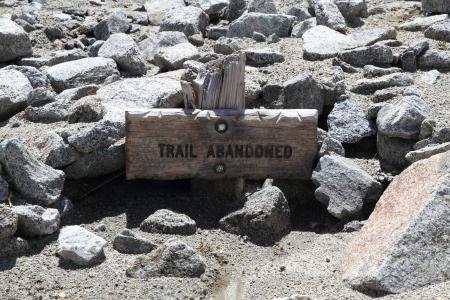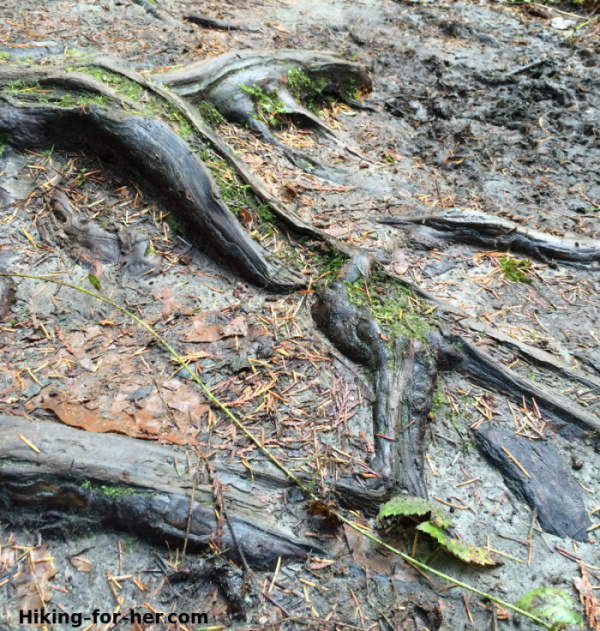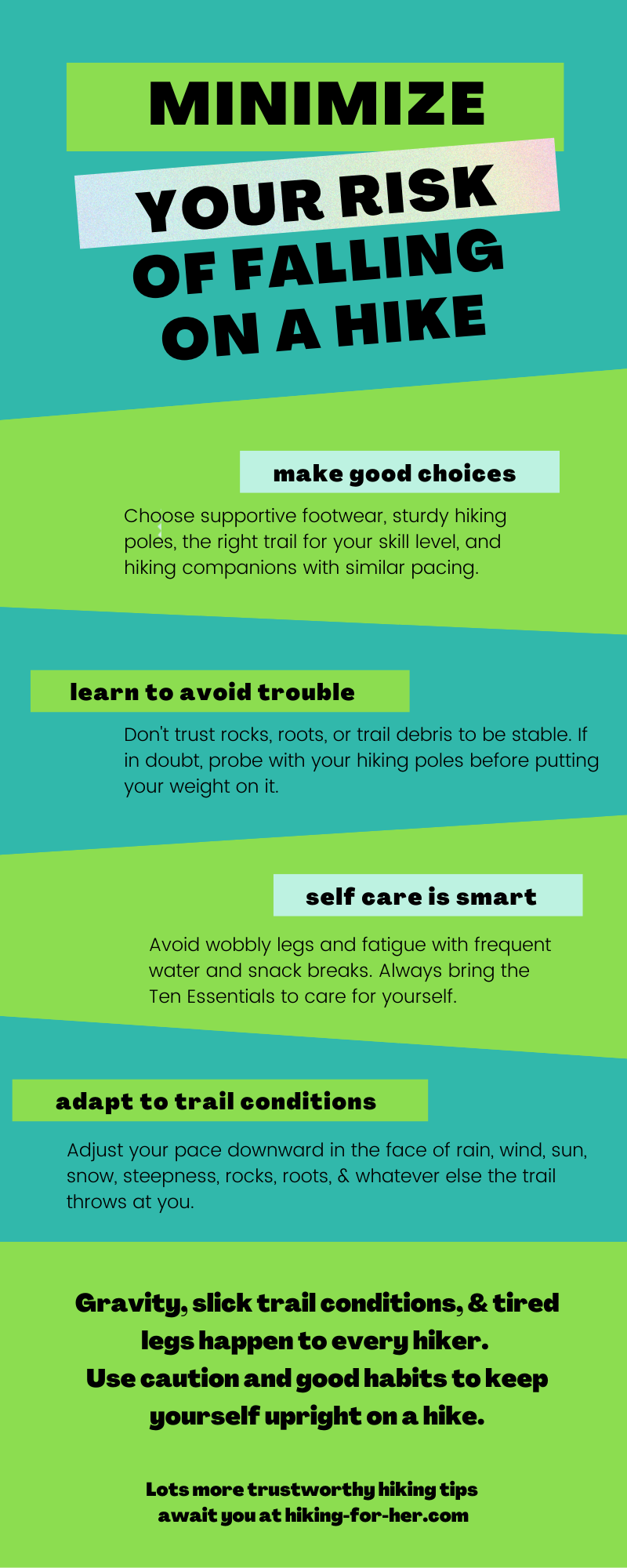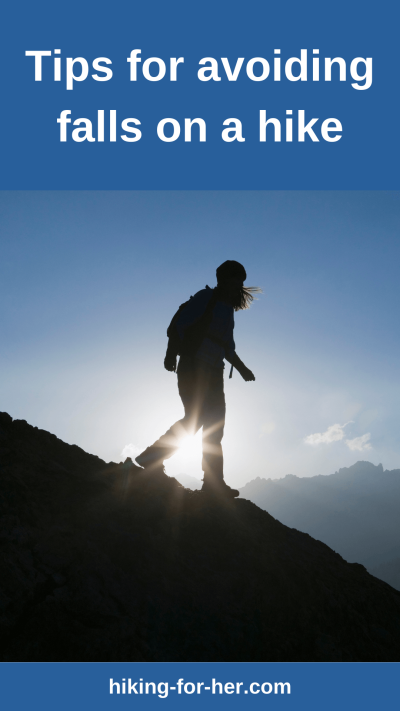
Falls On A Hike:
Best Ways To Stay Upright On A Hiking Trail
By Diane Spicer
Do you ever worry about the chance of taking falls on a hike?
Every hiker does!
- Slippery mud on a downhill slope
- Innocent looking rocks languishing in a stream
- Icy patches on a frosty bridge
- Tree roots that spring up out of nowhere and grab your ankles
Yup. I've been there a time or two.
But I've learned a few ways to avoid falling while hiking. That's why I'm here - to share my best hiking tips with you, my virtual hiking friend.
Most likely causes of falls on a hike
I'm going to divide the causes of falls on a hike into several categories, some of which might not make sense until you read about them.
You can drop down quickly to find what you feel applies to your hiking style. Or your curiosity :)
- Balance issues
- Footing choices
- Your personal quirks
- Physical limitations
- Situational factors
- Variations in trail conditions
- Arrogance
Or we can take these one at a time, until you feel comfortable with the entire repertoire of things you can do to prevent falls on a hike.
Forewarned is forearmed, as they say.
Let's start with balance issues.
Off balance?
You already know how graceful you may (or may not) be in daily life.
On a hiking trail, your balance is challenged constantly, in new and oftentimes exciting (oh, the irony) ways.
Examples of challenging situations
Here are a few classic scenarios all hikers must face while hiking:
- Crossing a stream or lake outlet on a log or rocks
- Navigating a talus pile (unstable rocks of various sizes)
- Traversing a forced trail bypass crisscrossed by networks of roots
- Scrambling over tree branches and leaves or pine needles to find the trail again
- Negotiating a rock or root infested section of trail in rain or snowfall
And there's another fun fact to be aware of.
Your balance may change throughout the hike.
Heads up!
Fresh legs give you stability, but as the day unfolds, your strength may wane.
Be extra cautious later in the day if you have challenging conditions to navigate.
Or if your thighs start to wobble on a downhill section of the trail.
Your medical history
There are medical conditions that make hiking a balance challenge. To name two:
- Parkinson's
- Multiple sclerosis
As a hiker, you can find organizations that bring together folks with these diagnoses for day hikes and backpacking trips.
Check out Pass To Pass (Parkinson's) and Hike MS.
Vertigo and hiking
Vertigo is a false sense of feeling off balance, or sensing that your surroundings are moving or spinning around you, when you are stable.
Inner ear disorders can cause vertigo.
Sensors in the ear tell the brain there are body movements, even when the eyes and related sensory neurons report no movement.
- A mismatch, and a jarring one at that, as your brain tries to sort things out for you.
Can someone with vertigo take a hike?
On the face of it, "no hiking in order to stay safe" would be the most conservative route.
Or maybe no hiking on cliffs?
It's a personal decision, and requires input from your health care team.
You, of course, have the final decision.
Keep in mind:
If vertigo is a chronic condition for you, plan your hikes carefully (avoid tricky footing and exposures).
- Take a hiking companion along who can help you through the dizziness.
If vertigo is a new problem, have it checked by your medical provider. It may indicate hypoglycemia (eat more often!), anemia (iron deficiency), dehydration (drink lots of water even if you don't feel thirsty), or medication side effects.
In any case, don't ignore vertigo, because it increases your chances of taking falls on a hike.
Footing choices affect your chances of falls on a hike
And by choice, I mean you're on a portion of the trail that kindly gives you options.
Let's look at an example.
A stream crossing that does not have a handy bridge
Option 1: You can rock hop.
Option 2: You can wade across.
Option 3: You can explore upstream and downstream for a log that happened to fall across the stream.
Each of these options has the potential for falling, though.
Let's run through a few ideas for safe footing choices.
If you rock hop, you want stable, dry rocks.
Good luck finding them, unless some kindly hiker ahead of you in time or distance has placed exactly the right rocks for your stride.
Here's where hiking poles can help you.
They can be used to probe each rock before you step on it.
And they can be used to assist your balance as you step from one rock to another.
What about wading across?
A safe crossing depends on so many factors!
- Read my safety tips for water crossings.
What about a handy log spanning the water?
Personally, I avoid using logs for stream crossings if at all possible.
They tend to stay damp, meaning a slick slime layer builds up and remains invisible but is waiting to rob you of the coefficient of friction you need to stay upright.
And the bark can slip off and take you with it.
Plus, I am not a Flying Walenda (use your favorite search engine to get the reference).
OK, let's summarize how to be a sure footed hiker
Long story short to avoid falls on a hike:
- All logs are suspect because they can be wet and slippery.
- All rocks are suspect because they can wobble or play host to slippery algae.
- Spaces between rocks are suspect, as they can trap your foot and leg to pull you off balance.
- All tree roots are suspect for the logs + rocks reasons.
- Fallen leaves in large amounts are slick, don't trust them on downhill slopes.
- Deep piles of pine needles and playground slides have something in common.
Caution!
Take small steps when in doubt, preferably with one foot on something stable and your arms near your sides.
Probe with a stick or hiking poles if you are uncertain about the safety of your next few steps.
Watch how your trail buddies navigate a tricky section of trail, watching for what wobbles or appears slick.
But you can do more!
Be proactive about safe footing
to avoid falls on a hike
There are gear choices you can make to enhance your footing. But you have to remember to bring them on hikes.
Or do what I do: Leave your safety gear in the bottom of your backpack during wet and snowy hiking seasons. You'll always have that measure of safety with you.
A few questions will help you be proactive to avoid falls on a hike.
Have you explored hiking traction devices?
- Read my thoughts with recommendations for what I know works.
Do your hiking boots have proper tread that can stand up to varying trail conditions in winter or fall?
If so, what shape is it in? It may be time for new boots.
- Read how I size up boot tread and other important boot factors.
Have you tried boot inserts to support each foot fall? Read more about choosing good insoles.
Some hikers love low cut hiking shoes and feel they get enough traction and support with minimalist footwear like trail runners. But it depends on the trail!
- Read more about trail shoes.
What are your thoughts on ankle support? If you're at all balance challenged, or hiking through rocky terrain, go for boots with adequate ankle support, mid rise at least.
- Read about your boot choices.
Choose your trails with good footing in mind. Read trail reports and trail descriptions ahead of time, and avoid hikes that set you up for falls.
 Your first clue that your footing may be challenged in unpredictable ways
Your first clue that your footing may be challenged in unpredictable ways
Personal quirks and limitations
that can lead to falls on a hike
Here are some questions about your hiking style to ponder in your quest to avoid falls on a hike.
Self tripping habits
Do you ever cross one leg over the other as you hike, maybe as you step over a fallen log or dance to that tune in your head?
How about the habit of crossing one hiking pole over the other?
- Both are great ways to trip yourself!
Ask me how I know ;)
Next time you hike, see if you are a self tripper.
Visualize this
Do you tend to get dizzy when you look up and then down quickly? (not vertigo, just a spinning sensation that passes quickly)
Do you wear bifocal or multifocal lenses when you hike?
Do you love to wear dark sunglasses, regardless of the light levels on a trail?
All of these can lead to fall, or cause you to misstep first and then fall.
- Be cautious about placing your feet on a challenging section of trail if any of the above describes you on a hike.
- And ditch the dark glasses in a deep forest or at dusk, please!
Self proclaimed weakness may lead to
falls on a hike
Do you identify as a hiker with "weak ankles"?
Have you already gone through a sprained or strained ankle, and feel you are left with a weakness there?
Are your sore knees making you feel weak?
If you've answered yes, you already know that you have a stability challenge.
Now rise to the challenge!
Pay attention and don't lose your focus when your footing becomes challenged (see section below).
Hiking hobbies and habits are linked to
the chance of falls on a hike
Are you a photographer who snaps pictures without setting up stable footing first?
Are you a birder, caught up in the excitement of spotting a new bird and forgetting to glance down at where your feet are?
Are you a conversationalist on a hike, getting deeply into a thought and turning your head to the side to share it - without thinking about where your feet are going?
Are you using electronic devices for navigation or social media posts, literally as you hike?
Are you always getting back to the trailhead or your campsite at dusk without a headlamp to guide you?
Do you push hard and run out of steam on the way back to the trailhead?
Do you dress appropriately for the variable weather conditions you may face, or do you shiver or overheat?
These are vulnerable times for you as a hiker.
Awareness is your secret weapon to avoid falls on a hike.
- Try to be more aware of the disconnects between your brain ("let's do this fun thing") and your feet ("gotta keep moving") before you take a fall on a hike.
Your biometrics as a hiker
Finally, take a moment to think about your natural stance and stride as a hiker.
- Keeping feet close together gives potential for a fall if one leg knocks against the other.
- A wider stance leads to more stability.
- A too wide stance, or taking big steps, makes you kind of sway in the wind, depending on trail conditions.
- Not adjusting your stride to the slope of the trail leaves you off balance.
Channel Goldilocks and go for a "just right" stance as a hiker.
This is especially important on downhill stretches of trail, when leaning too far forward sets you up for falls.
Know thyself, and then what?
So how can you avoid falls on a hike if you answered "yes" to any of these questions?
If you really want a challenge, break any habits of setting yourself up for a fall, as noted above.
This may take time, but is well worth it.
First, notice when you are working against yourself. If you trip and have to catch yourself, what were you doing?
Next, decide what to do differently (or eliminate) next time.
Third, be patient. You're unraveling an ingrained habit while learning a new habit.
It will take some time to incorporate something new into your hiking style.
But meanwhile, to minimize the risk of falls on a hike:
- Be mindful of your habits. Watch yourself as you hike through various terrain and trail conditions.
- Counteract the tendency to work against yourself by saying something encouraging like "Careful there" when you do it! (I always say "Whoa, Nelly!" if I trip and nearly fall, but that's just me.)
- To be even more proactive, look at a topographical map of your hiking itinerary the day before, and take mental note of where the trail may challenge you the most.
- Allow extra time on a hike with tricky footing issues that you know will challenge you.
Personal limitations can also lead to
falls on a hike
Do you have sore muscles even before a hike?
Do you live with arthritic hips or knees?
You know what your limitations are, and how they can make you feel off balance or shaky.
Here are a few tips just for you:
Onward in spite of it all!
My recommendation is to keep hiking with your personal limitations as much as possible, but cherry pick your hikes.
- Avoid terrain that sets you up for potential falls: tree roots and rocky outcrops on a downward slope on a rainy day, for example.
Here's another idea.
Get a personal trainer, or take some yoga classes, to introduce more strength, balance and flexibility into your body.
Then slowly introduce more challenging terrain into your hiking repertoire.
See where your "end feel" lies, and then find lots of hikes with that kind of distance and terrain.
Maybe you can move that "end feel" a bit!
Keep notes on what was challenging on a hike, so next time you will be prepared.
- A trail journal is great for this.
Situational factors that influence
your chance of falls on a hike
Let's roll through a few personal choices that can affect your ability to stay upright on a hike.
Canine trail companions
Hiking with a dog on a leash: one unexpected lunge and down you go.
- Use a dog harness that clips to your waist and gives you good hand control over the animal.
- Work with your dog to respond to voice commands that minimize the risk of lunging.
- Train your dog to handle unexpected events such as an animal crossing the trail.
- Make sure your canine is properly equipped to hike with you.
- More tips for hiking with dogs
Your hiking gear and supplies
A backpack that isn't packed correctly will be troublesome: too top heavy, or shifting weight as you hike uphill or downhill.
- Be prepared with these tips on how to pack a backpack.
A hiking backpack that is too big for you will also throw off your balance.
- Find the perfect backpack with these tips.
Your hydration status is more important that you know: not enough water can lead to dizziness or feeling faint, poor judgement, and fatigue.
Low blood sugar can also lead to bad outcomes during a hike.
- Pack the best hiking food before you head out on your next hike. And don't skimp on the trail snacks.
Bottom line
You're in control of your dog, your gear, your food and water intake.
So make changes to your current approach in order to minimize your chances of falling on a hike.
Trail conditions that set you up
for falls on a hike
Every hike is unique. That's why we hike, right?
Part of this "new every time" vibe is the weather.
Another big part?
The terrain.
Combine the two, and it's "choose your own adventure" time!
I think you're with me when I say that the weather can turn the terrain you hiked last week (or this morning) into something altogether more challenging, in terms of how to find safe footing.
 Don't use Mother Nature's slip-and-slide
Don't use Mother Nature's slip-and-slide
Weather can influence your chance of falls on a hike
I may be stating the obvious, but it's important to note that trails get slippery as soon as the first raindrops hit.
- Do you slow down and adjust your pacing to match the wet trail's mud, rocks, holes and roots?
That's a pivotal question, my friend! Here's my truth:
One of the worst tumbles I ever took on a hiking trail was because I was going too fast, chugging along when it started to rain - because I knew that trail like the back of my hand.
And I got a chance to study the back of my hand close up, after I face planted.
That little tumble humbled me forever.
So please heed my advice:
- Slow down and match your pace with the type of footing you encounter, section by section, on your ever evolving hike.
Also realize that if it begins to rain or snow while you're on a hike, your return trip to the trailhead -or forward movement on a backpacking trip- has been altered for you by our dear Mother Nature.
Be smart!
Slow down.
Look first, then take that big step over a tree trunk or rock.
Use hiking poles to probe anything that looks suspiciously slippery.
If you need to use vegetable belay tactics (clinging to handy tree limbs or rocks) to get down a stretch of steep rock or roots, you have my permission to do so.
You can also use butt belays, when needed. That's when good rain pants like these help you out.
Be cautious, even when it slows you down
You're a prepared hiker (carrying the ten essentials), so you can afford a bit of extra time for safe navigation.
Things to watch out for on a trail:
- Dry leaves and pine needles can be surprisingly slick, especially on a downhill slope.
- Leaf debris can cause you to slide when it becomes a soggy mess.
- Leaves and downed limbs can hide underlying jagged rocks or slippery limbs, so step carefully on them any time of year.
- Moss and fallen forest debris will mask gaps between rocks and logs, creating a trap for your feet.
- Dry tree or shrub roots can turn treacherous when it begins to rain, as a hydroplaning effect builds.
- A bridge made of wooden planks will turn into an ice rink at the right temperature, or with the right amount of water on it.
- Wet rocks are never to be trusted, due to their slime layer that robs you of traction.
- Dry, mossy rocks will become less reliable as the moss becomes saturated in rain or snow.
- Downhill sections of trail are good times to slow down. Gravity is not your friend on slippery slopes.
- If you encounter wooden steps on a trail, don't step on the wooden tread. Instead, step on the dirt between the treads.
Arrogance may play a role
in falls on a hike
If you're hiking with someone who feels immortal and pushes trail conditions to the max while setting a wicked pace despite the footing, please reconsider your choice of trail partners.
If you enjoy taking risks, great! Join the immortal one.
If you feel at all pushed or worried about your safety, speak up. If that doesn't work, switch hiking partners.
Simple as that!
You have the power to hike your own hike, always.
A word to the hiker who "never" falls
Gravity is a stern mistress to everyone on this planet.
As well as those who want to escape it (just sayin', Elon and Jeff and Richard).
Your time will come, like it or not, prepared or not, no matter how many precautions you may take.
Here's the silver lining in that unpleasant little hiking truth.
Falls on a hike may turn out to be a good thing, if they make you think more about your safety as a hiker.
Always carry a survival kit and a communication device, even (especially) if you "never" fall.
Your tool chest of tips to prevent
falls on a hike is now complete
I can't guarantee that you'll never take a tumble after reading these tips on how to avoid falls on a hike.
But at least you can enhance the odds that you can focus on (water)falls, not (foot)falls.
I'll leave you with one last tip:
- If you feel yourself falling forward, resist the urge to break your fall by flinging out your arms or hands. That's how wrist bones get broken.
- If you fall backwards, let your backpack absorb the impact, to avoid twisting your neck or torso.
There you have it! Lots of ways to avoid falls on a hike.
My first serious fall on a hike served as a giant wake up call, which is why I'm sharing what I know with you about how to avoid falls on a hike.
May all your hikes be in full control of gravity!
Home page > Hiking Self Care >
Tips To Prevent Falls On A Hike
|
I get emails all the time about what I wear, eat, carry and love to use on the trail. That's
why I provide affiliate links to you: the best gear that I use myself and have seen used by other hikers is instantly
available for your consideration, and the gear company sends a few
pennies per dollar to this reader-supported hiking website. There is no added cost to you! Everyone ends up a winner: Great gear for you, strong gear companies, and more free hiking tips for everyone. Thanks very much for your support. It's warmly and sincerely appreciated. It also helps send these hiking tips to all your virtual trail buddies around the globe. |
 |



